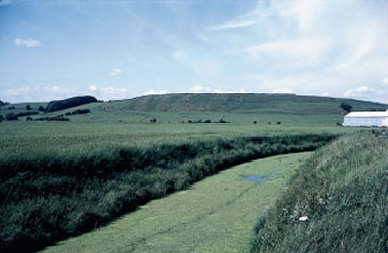3.2.3 Agricultural fertilizers
Runoff from intensively farmed land often contains high concentrations of inorganic fertilizer. Nutrients applied to farmland may spread to the wider environment by:
drainage water percolating through the soil, leaching soluble plant nutrients;
washing of excreta, applied to the land as fertilizer, into watercourses; and
the erosion of surface soils or the movement of fine soil particles into subsoil drainage systems.
Some water bodies have been monitored for long periods, and the impact of agricultural runoff can be demonstrated clearly. In the 50 years between 1904 and 1954, for example, in Loch Leven, Scotland, there were major changes in the species composition of the community of photosynthetic organisms. The species composition of the green alga community changed and the numbers of cyanobacteria rose considerably. Increasingly since then, large blooms of filamentous cyanobacteria have been produced in the loch. These changes have been linked with trends in the use of agricultural fertilizers and other agrochemicals.
In Europe, large quantities of slurry from intensively reared and housed livestock are spread on the fields (Figure 3.3). Animal excreta are very rich in both nitrogen and phosphorus and therefore their application to land can contribute to problems from polluted runoff. Land use policies have concentrated livestock production into purpose-built units, increasing the pollution risks associated with handling the resultant slurry or manures.

European agricultural policies that subsidize agriculture on the basis of productivity have also encouraged the use of fertilizers. Use of fertilizers has undergone a massive increase since 1950. In the USA, by 1975, total use of inorganic fertilizer had reached a level equivalent to about 40 kg per person per year. A recent European Environment Agency report estimated that the groundwater beneath more than 85% of Europe’s farmland exceeds guideline levels for nitrogen concentration (25 mg l−1), with agricultural fertilizers being the main source of the problem. Pollution of surface waters also occurs on a large scale. A survey by the UK’s Environment Agency in 1994 found that over 50% of the 314 water bodies surveyed in England and Wales had algal blooms caused by fertilizer runoff (Figure 3.4).

Patterns of fertilizer use do differ considerably between countries. In those with poorly developed economies, the costs of artificial fertilizers may be prohibitive. In hotter climates, irrigation may be used, resulting in higher nutrient runoff than for equivalent crops that are not irrigated. The high solubility of nitrate means that agriculture is a major contributor to nitrogen loadings in freshwater. Agriculture accounts for 71% of the mass flow of nitrogen in the River Great Ouse in the Midlands, UK, compared with only 6% for phosphorus.
SAQ 18
What are the main sources of phosphorus and nitrogen that enrich rivers in a developed country
Answer
Phosphorus comes primarily from domestic waste water, whilst nitrogen comes primarily from intensive agriculture.
